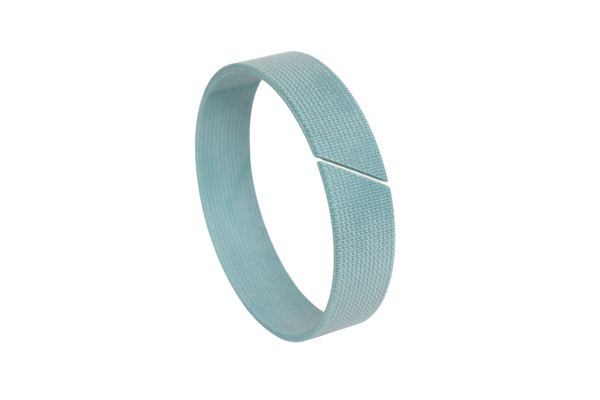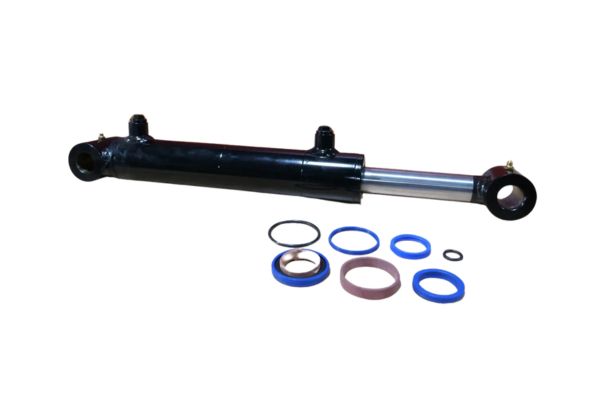Hydraulic cylinders are essential in many industrial applications, ensuring smooth, efficient, and reliable movement. A crucial component of these cylinders is the hydraulic cylinder guide ring. These guide rings are designed to enhance system performance, reduce wear, and extend the lifespan of hydraulic equipment. In this article, we will explore the functions of hydraulic cylinder guide rings, the different types available, their benefits, and how they impact the overall performance of hydraulic systems.
What Are Hydraulic Cylinder Guide Rings?
Hydraulic cylinder guide rings are components installed within hydraulic cylinders to guide the piston rod and prevent metal-to-metal contact. Their main job is to ensure that the piston moves smoothly within the cylinder without causing wear on other components. But here’s the kicker—the guide rings help maintain the proper alignment of the piston and seals, thus enhancing the system’s overall efficiency.
The Role of Guide Rings in Hydraulic Cylinders
Hydraulic systems rely on smooth and controlled motion, and guide rings ensure just that by preventing unnecessary friction. Guide rings keep the piston rod in its correct position, which allows the entire hydraulic system to operate more effectively. Additionally, guide rings protect seals and internal components from direct contact with the cylinder walls, which minimizes the risk of wear.

Material and Durability
The materials used for guide rings vary depending on the type of hydraulic system. Materials like polyurethane, bronze, and various polymers are common choices. These materials are selected for their wear resistance, durability, and ability to withstand the pressures and temperatures common in hydraulic applications.
What Are the Functions of Hydraulic Cylinder Guide Rings?
Hydraulic cylinder guide rings serve several critical functions in hydraulic systems. The primary function of guide rings is to ensure smooth movement of the piston. Without them, friction would increase, leading to faster wear of the components. But here’s the deal—guide rings don’t just minimize friction; they also extend the lifespan of hydraulic cylinders by ensuring that the system operates efficiently over time.
Friction and Wear Reduction
Guide rings reduce friction by providing a cushion between the moving piston and the cylinder barrel. This not only prevents wear but also reduces the risk of overheating due to frictional forces. By minimizing wear, guide rings ensure that the system remains efficient for a longer period.
Alignment and Support
Guide rings maintain the alignment of the piston rod, ensuring that it moves smoothly within the cylinder. This is crucial because misalignment can cause uneven wear and eventually damage the seals and other internal components. The guide rings also support the seals, which are responsible for keeping the hydraulic fluid contained within the cylinder. Proper alignment and support are essential for the system’s long-term operation.
Seal Protection
Guide rings play a vital role in protecting seals by preventing them from coming into direct contact with the piston or cylinder wall. By maintaining proper positioning, guide rings help ensure that the seals remain intact and function effectively, which prevents leakage and maintains the hydraulic pressure.
Types of Hydraulic Cylinder Guide Rings
Guide rings come in various types, each suited for different applications. The most common types are solid guide rings, split guide rings, and custom guide rings. Understanding these options is crucial for selecting the right guide ring for your hydraulic system.
Solid Guide Rings
Solid guide rings are made from a single piece of material and are commonly used in general hydraulic systems with moderate pressure and temperature conditions. They are durable, easy to install, and provide excellent support for the piston and seals. However, solid guide rings may not be suitable for high-pressure systems or systems with fluctuating temperatures.
Split Guide Rings
Split guide rings are designed in multiple sections, making them easier to install and remove. This design is ideal for high-pressure systems or systems that need frequent maintenance. The split design also allows for flexibility, as it can accommodate temperature and pressure changes more easily than solid guide rings.
Custom Guide Rings
Custom guide rings are designed for specific applications, particularly in extreme conditions such as high temperatures, high pressures, or abrasive environments. These rings can be made from various materials, including special alloys or polymers, to meet the unique demands of the system.
Why Are Openings Used in Hydraulic Cylinder Guide Rings?
You might be wondering why some hydraulic cylinder guide rings have openings. The answer lies in the performance benefits that these openings offer. Openings in guide rings serve two key purposes: they allow for better lubrication and help distribute pressure more evenly across the guide ring.
Lubrication Distribution
Hydraulic cylinders operate under high pressure, which can cause significant friction between the moving piston and the cylinder walls. Openings in guide rings allow hydraulic fluid to flow more freely, ensuring that the moving parts are continuously lubricated. This lubrication reduces friction, which in turn lowers the risk of wear and overheating.
Even Pressure Distribution
Openings also help to distribute pressure evenly across the guide ring. This is important because localized pressure points can lead to wear and failure of the guide ring. By ensuring that pressure is spread evenly, the guide ring can withstand the demands of high-pressure environments.

System Efficiency
The result of having openings in guide rings is a more efficient system. The guide ring operates with less friction, lower energy consumption, and better heat dissipation. This ultimately leads to a longer-lasting hydraulic system with fewer maintenance requirements.
How Hydraulic Cylinder Guide Rings Improve Performance
Hydraulic cylinder guide rings are essential for improving the overall performance of hydraulic systems. These rings provide stability, minimize friction, and extend the life of the system, which leads to better overall performance.
Smoother Operation
By guiding the piston and reducing friction, guide rings ensure that the hydraulic cylinder operates smoothly. This smooth operation reduces the wear on seals and other components, leading to less downtime and maintenance. It also reduces the energy required to move the piston, making the system more energy-efficient.
Reduced Maintenance Costs
With reduced wear and tear on the components, the overall maintenance costs of the hydraulic system are lowered. Fewer repairs and replacements are required, which translates into significant cost savings for companies that rely on hydraulic systems for daily operations.
Enhanced Reliability
Hydraulic systems with well-maintained guide rings are more reliable. The rings ensure that the piston moves smoothly and remains aligned, preventing failures that could lead to system downtime. As a result, hydraulic systems with guide rings are more dependable and efficient, which is crucial in industries where machinery uptime is critical.
Common Materials Used for Hydraulic Cylinder Guide Rings
The materials used for hydraulic cylinder guide rings vary depending on the application and operating conditions. Some materials are more suited for high-pressure environments, while others are better for low-friction applications. Let’s take a closer look at the most common materials used for hydraulic cylinder guide rings.
Polyurethane
Polyurethane is one of the most commonly used materials for guide rings due to its wear resistance and flexibility. It is ideal for moderate-pressure systems and is often used in applications where high flexibility is required.
Bronze
Bronze guide rings are known for their durability and corrosion resistance. They are typically used in high-pressure systems where strength and resistance to wear are critical. Bronze guide rings also have excellent heat dissipation properties, which makes them suitable for high-temperature environments.
Custom Polymers
For extreme conditions, custom polymers or composite materials are often used. These materials are designed to withstand high pressures, temperatures, and abrasive environments. Custom polymers offer high resilience and are tailored to meet the specific needs of different hydraulic applications.
How to Choose the Right Hydraulic Cylinder Guide Ring
Choosing the right hydraulic cylinder guide ring depends on several factors, including the pressure rating, material compatibility, and the environment in which the system will operate. So, what should you consider when selecting a guide ring for your hydraulic system?
Pressure Rating
The pressure rating of the hydraulic system plays a key role in choosing the right guide ring. For high-pressure systems, guide rings made from durable materials like bronze or custom polymers are necessary. For moderate-pressure systems, polyurethane guide rings may be sufficient.
Temperature Compatibility
Hydraulic systems that operate in extreme temperatures require guide rings made from materials that can withstand heat. Polyurethane and custom polymers are good choices for systems that need to perform under high-temperature conditions.
Environmental Conditions
The environment in which the hydraulic system operates is also a crucial consideration. Systems that work in harsh conditions, such as mining or construction environments, require guide rings made from materials that can withstand abrasives and extreme pressures.
Size and Fit
The size and fit of the guide ring are just as important as the material. Guide rings that are too large or too small can cause misalignment, resulting in uneven wear and system failure. Proper sizing ensures that the guide ring fits perfectly and operates smoothly.
Installation Process of Hydraulic Cylinder Guide Rings
Installing hydraulic cylinder guide rings correctly is crucial for the optimal performance of the hydraulic system. A proper installation ensures the guide ring works effectively, preventing unnecessary wear and damage to the system. So, how do you go about installing hydraulic cylinder guide rings?
Step 1: Clean the Cylinder Thoroughly
Before installing the guide ring, make sure the cylinder is thoroughly cleaned. Contaminants such as dirt, debris, and other foreign particles can damage the guide ring during installation or cause it to wear out prematurely. Cleaning the cylinder ensures a smooth surface for the guide ring, helping it to fit perfectly and operate efficiently.
Step 2: Install the Guide Ring with Precision
Next, carefully place the guide ring into the cylinder. It’s essential that the guide ring fits snugly and is positioned correctly. Misalignment during installation can lead to uneven wear, making the system inefficient and causing potential damage. Take the time to check the alignment and ensure that everything fits into place properly.
Step 3: Lubricate the Guide Ring
Once the guide ring is in place, apply the appropriate lubrication. Lubricating the guide ring before installation reduces friction, which can cause excessive wear. It also helps the guide ring and other components move smoothly during operation. The right lubrication significantly extends the life of the guide ring and improves overall system performance.
Step 4: Inspect and Test the Installation
After installation, perform a thorough inspection to ensure everything is aligned and functioning properly. A visual check is essential to confirm that the guide ring is securely in place and there are no misalignments. Additionally, a test run of the system will help identify any operational issues before full-scale use.
Common Problems with Hydraulic Cylinder Guide Rings
Like all mechanical components, hydraulic cylinder guide rings can experience issues over time. The key to maintaining a reliable hydraulic system is to be aware of common problems and address them quickly. But here’s the kicker—understanding these common issues helps you prevent system failures before they happen.
Wear and Tear
The most common issue with hydraulic cylinder guide rings is wear due to friction. Over time, the constant movement of the piston against the guide ring causes wear, reducing its efficiency. This wear can lead to leakage or damage to the seals, which will affect the system’s performance. Regular inspection is crucial to detect signs of wear early and take corrective action.
Misalignment
Guide rings can also become misaligned over time, especially if they were not properly installed or if they experience excessive wear. Misalignment can lead to uneven wear, increased friction, and potential damage to the seals or piston. Ensuring proper installation and regularly checking alignment can prevent this issue.
Contamination
Contamination is another major issue for hydraulic systems. Dirt, debris, or other contaminants can enter the hydraulic system, damaging the guide rings and other components. Contaminants can cause excessive wear, leaks, or even system failure. Regular cleaning and filtration of the hydraulic fluid is essential to prevent contamination from affecting the guide rings.
Maintenance Tips for Hydraulic Cylinder Guide Rings
Maintaining hydraulic cylinder guide rings is essential for ensuring the long-term efficiency and reliability of the hydraulic system. Regular maintenance prevents costly repairs, extends the life of the guide rings, and ensures optimal system performance. So, what are the best practices for maintaining hydraulic cylinder guide rings?
Inspect Regularly for Wear and Damage
Routine inspections of guide rings should be part of any maintenance schedule. Look for any signs of wear, cracks, or irregularities. Wear is a natural process, but catching it early can prevent larger issues from arising. If the guide ring is showing significant damage, it’s crucial to replace it before it causes further damage to the system.
Lubricate the Guide Rings
Proper lubrication is key to reducing friction and preventing wear. Lack of lubrication can lead to increased friction, which accelerates wear and reduces system efficiency. Be sure to lubricate the guide rings according to the manufacturer’s recommendations. Lubricating the guide rings regularly ensures that they continue to operate smoothly and efficiently.
Keep the System Clean
Maintaining a clean hydraulic system is vital to the longevity of the guide rings. Dirt, debris, or other contaminants can enter the system and cause significant damage to the guide rings and other components. Regularly clean the system and replace the filters to ensure that no contaminants get inside.
Replace When Necessary
Even with regular maintenance, guide rings will eventually wear out and need replacing. If your guide rings are showing signs of significant wear or damage, replace them promptly to avoid causing further issues in the hydraulic system.
Conclusion
In conclusion, hydraulic cylinder guide rings are essential components for the smooth and efficient operation of hydraulic systems. They reduce friction, extend system life, and prevent wear, making them vital in maintaining hydraulic system reliability. Whether in construction, automotive, aerospace, or industrial applications, guide rings play a crucial role in ensuring performance and reducing maintenance costs.
FAQ
What is a hydraulic cylinder guide ring?
A hydraulic cylinder guide ring is a component used to guide the piston rod within the cylinder, preventing wear and ensuring smooth operation.
How does a hydraulic cylinder guide ring work?
Guide rings reduce friction, prevent metal-to-metal contact, and help align the piston rod within the cylinder, improving system efficiency.
Why are openings used in hydraulic cylinder guide rings?
Openings in guide rings allow for better lubrication distribution, reducing friction and improving system performance under high pressures.
How do I choose the right hydraulic cylinder guide ring?
Consider factors like pressure rating, material compatibility, temperature, and the specific application to select the most suitable guide ring.
How do I maintain hydraulic cylinder guide rings?
Regular inspection for wear, proper lubrication, and cleaning are essential for maintaining guide rings and ensuring long-term system performance.
What are hydraulic cylinder guide rings used for?
Hydraulic cylinder guide rings are used to ensure smooth movement of the piston within the cylinder, reduce wear on the cylinder and piston, and maintain proper alignment under high pressure.





